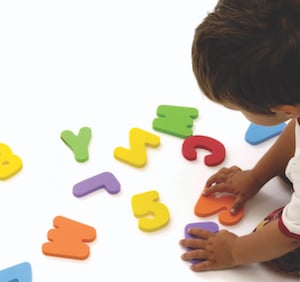Have Fun with Letters
It’s never too early to start building your child’s literacy skills—and the Center for Early Literacy Learning (CELL) can help. It offers parents and professionals free practice guides that show how you can use everyday activities to encourage infants, toddlers, and preschoolers to listen, talk, and learn the building blocks for early literacy. You can learn more about CELL practice guides at earlyliteracylearning.org/pgparents.php .
Here is an excerpt* from one of the guides you can use with your toddler.
What’s Your Letter?

Before children can begin to read or write, they need to become familiar with the look and shape of letters. Interacting with letters they can see and touch—letters with different textures, colors, and sizes—helps children become interested in and comfortable with the alphabet. Providing alphabet toys for your child and encouraging his interest through praise and conversation will help him begin to understand the way our alphabet is used and organized. Playing with alphabet toys can help toddlers feel confident about learning.
What is the Practice?
Interacting with your child around a wide variety of alphabet toys makes letter learning fun. These toys can be alphabet blocks, magnetic or foam letters, alphabet puzzles, or any other toys with the letters prominently displayed so your toddler has many occasions to look at them.
What Does the Practice Look Like?
Let your toddler play with letter-shaped cookie cutters in damp sand, cornmeal, play dough, or real dough. Cut kitchen sponges into letter shapes and show her how to use them as bathtub toys or as stamps with finger paint. When you enjoy these kinds of activities together while talking to your toddler about what he’s doing, you’re making good use of alphabet toys. Let your child arrange magnetic alphabet letters on the refrigerator door, stack alphabet blocks, string large alphabet beads, and much more. Each play time with alphabet toys helps him become more familiar and comfortable with letters.
How Do You Do the Practice?
Make play with alphabet toys fun for your toddler by providing a variety of materials, praising her efforts, and following her lead.
- Help your child start to learn the letters in her name by pointing out the blocks, stamps, or other materials that have those letters. Praise her when she finds or recognizes them.
- Point out that each letter toy your child is playing with stands for a sound. For example, when your child hands you the block with the letter B on it, name the letter and its sound, and encourage him to do the same.
- Try to avoid making alphabet toys seem too “hard” or too much like work. Even if he doesn’t seem to be paying attention to the letters themselves, they are still becoming more familiar to him, which will make them easier to learn later on.
How Do You Know the Practice Worked?
- Does your child play enthusiastically with alphabet toys?
- Does your child point out familiar letters on his toys or anywhere else he sees them?
- Does your child imitate you by naming sounds and letters when you are playing with alphabet toys together?
